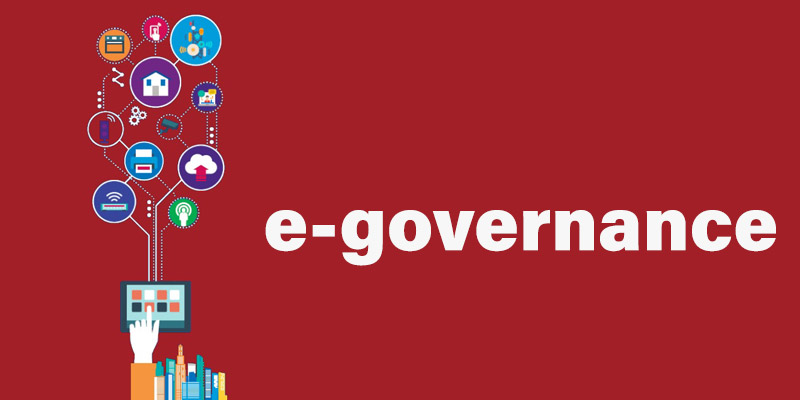e-Governance is the premium indicator for public service delivery in India. Elaborate in detail the level of e-Governance in India with reference to the recently announced National Awards for e-Governance.
E-Governance is a transformative approach to public administration, leveraging Information and Communication Technology (ICT) to enhance governance efficiency, citizen engagement, transparency, and accountability. It embodies the spirit of “SMART Governance” — Simple, Moral, Accountable, Responsive, and Transparent.
Significance of e-Governance:
- Applications of e-governance in India involve using digital tools and platforms to streamline interactions between government, citizens, businesses, and employees. These applications are crucial for improving service delivery, fostering transparency, and enhancing participation in democratic processes.
e-Governance is important for achieving the following qualities in service delivery.
Transparency: Reduces corruption through public access to information.
Efficiency: Streamlines workflows and reduces paperwork.
Economic Development: Reduces transaction costs and enhances rural prosperity.
Social Inclusion: Empowers marginalised sections through participatory governance.
Service Quality: Enhances responsiveness and accountability in service delivery.
With 70% of India’s population residing in rural areas, e-governance has immense potential to bridge rural-urban disparities.
Initiatives like Digital India and CCTNS (Crime and Criminal Tracking Network & Systems) enhance rural access to crucial information on markets, healthcare, education, and government schemes.
- Emerging technologies like Artificial Intelligence (AI), Machine Learning (ML), and Robotics are reshaping e-Governance. Web 2.0, characterised by interactive digital platforms, facilitates document sharing, online discussions, and feedback mechanisms.
FASTER (Supreme Court): A digital platform to communicate judicial orders electronically.
SUPACE: A Supreme Court tool for aiding judges with relevant facts and laws.
Applications of e-Governance in India
Government to Citizens (G2C) Initiatives
G2C applications focus on extending governance to citizens through efficient service delivery and transparency.
- SVAMITVA Scheme: Enables rural property documentation using drone technology, empowering rural citizens economically.
- Shram Suvidha Portal: Simplifies enforcement of labor laws via an online inspection system.
- Jan Soochna Portal (Rajasthan): Offers public access to government-related information, ensuring transparency.
- CPGRAMS: An online grievance redressal platform for citizens to lodge complaints 24×7.
- e-Mitra (Rajasthan): Provides government and private sector services under one roof through Public-Private Partnership (PPP) models.
Government to Business (G2B) Initiatives
e-Governance fosters a conducive environment for business operations.
- SPICe+: A streamlined web-based form for company incorporation with real-time data validation.
- MCA21: An initiative by the Ministry of Corporate Affairs to provide online registry-related services, enhancing transparency and reducing processing time.
Government to Government (G2G) Initiatives
G2G applications improve internal governmental processes, boosting operational efficiency.
- PARIVESH: A web-based platform for seeking and monitoring forest, environment, and wildlife clearances.
- PRAGATI: A multi-purpose platform for monitoring important government projects and addressing inter-governmental issues.
Government to Employees (G2E) Initiatives
These applications ensure better communication and service delivery to government employees.
- iGOT Karmayogi: An online training platform for lifelong learning and career development of employees.
- e-Postal Ballot: Enables electronic voting for specific sections of the electorate, improving inclusivity.
Social Networking Sites (SNS) in e-Governance:
The digital revolution and the proliferation of Social Networking Sites (SNS) have added a new dimension to governance. Governments leverage SNS to:
- Disseminate real-time information.
- Gather feedback for policy planning and execution.
- Enable citizen engagement in decision-making.
National Awards for e-Governance (NAeG) 2025:
They are presented every year to recognize and promote excellence in implementation of e-Governance initiatives.
| S No | Name of the Project | Organisation Name |
| 1 | Mining Tenement System | Indian Bureau of Mines (IBM), Ministry of Mines |
| 2 | Multi Hazard Early Warning Decision Support System | India Meteorological Department |
| 3 | SAMPADA (Stamps And Management of Property And Documents Application) 2.0 | Commercial Tax Department of the Government of Madhya Pradesh (MP) |
| 4 | Project Monitoring System and Water Quality Monitoring Information System | State Mission Management Unit, Kerala |
| 5 | Digital India BHASHINI Division | Ministry of Electronics and Information Technology |
| 6 | Digi Yatra | Ministry of Civil Aviation |
| 7 | National Animal Diseases Referral Expert System- Integrating Data Driven Disease Surveillance and Predictive Analytics for Livestock Diseases (NADRES V2) | ICAR – National Institute of Veterinary Epidemiology and Disease Informatics |
| 8 | Robust cybersecurity measures in IT-OT convergence for railway systems – “Best e-Gov Practices/Innovation in Cyber Security” | National Capital Region Transport Corporation (NCRTC) |
| 9 | Data Harmonisation for Risk Insights and Security Threat Intelligence (DHRISTI) | National Informatics Centre (NIC) |
| 10 | Quantum Safe VPN | Ministry of Defence |
| 11 | Bruhat Bengaluru Mahanagar Palike – Contactless, Faceless & Online eKhata & Digitized Property Records Management System | Bruhat Bengaluru Mahanagar Palike (BBMP), Government of Karnataka |
| 12 | Amin Management System | Gangtok, Sikkim |
| 13 | Rohini Gram Panchayat | Dhule District, Maharashtra |
| 14 | West Majlishpur Gram Panchayat | West Tripura District, Tripura |
| 15 | Sampurna Shiksha Kavach | Latehar District Administration, Jharkhand |
| 16 | Drone Analytics Monitoring System (DAMS) for Highway Management | National Highways Authority of India |
Challenges in e-Governance
Despite its advantages, e-Governance faces challenges:
- Digital Divide: Unequal access to ICT infrastructure, especially in rural areas.
- Data Security: Risks of cyberattacks and data breaches.
- Resistance to Change: Hesitancy among traditional administrative setups to adopt new technology.
Way Forward
Over the years, e-Governance has evolved from mere computerization of government offices to a robust framework facilitating seamless interaction among stakeholders. To even more exponentiate its potential,
- Capacity Building: Regular training for government officials.
- Infrastructure Development: Expanding internet and mobile connectivity in remote areas.
- Cybersecurity: Strengthening legal frameworks and technological safeguards.
- Public Awareness: Educating citizens about e-Governance benefits and usage.
Source:
https://www.pib.gov.in/PressReleseDetail.aspx?PRID=2131606

